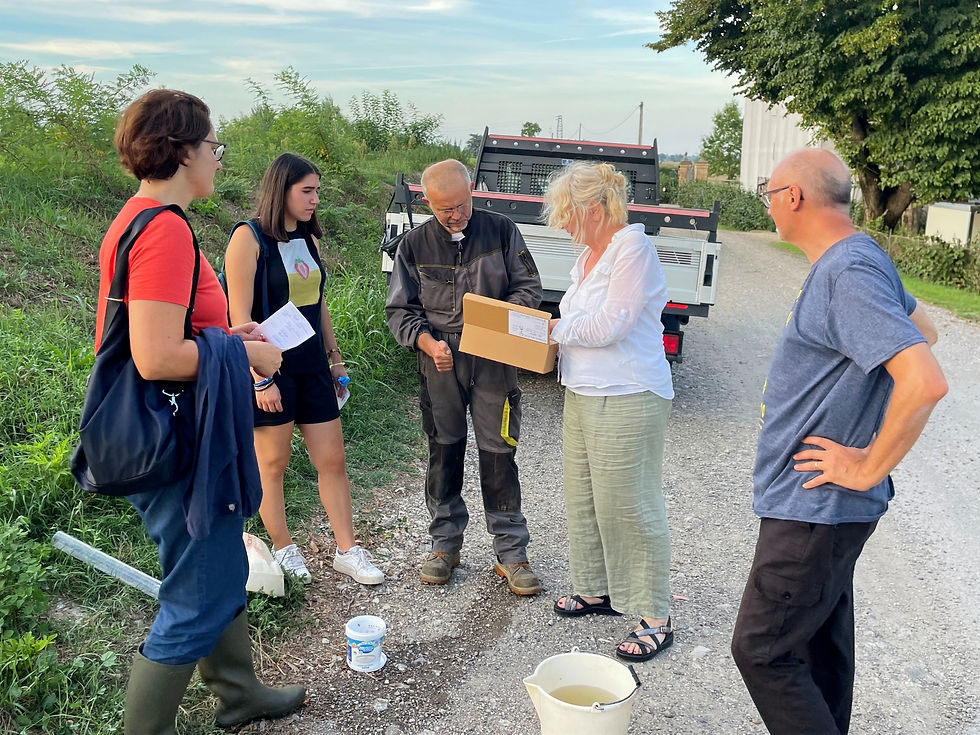Watching over Loggerhead Turtle Nests
- Ashley Eugley

- Aug 4, 2022
- 4 min read
Updated: Aug 20, 2022
Today I began volunteering with the Turtle Nest Patrolling and Guarding Program overseen by Nature Trust Malta (NTM) and Malta's Foundation for Environmental Education (FEE) at Ramla Beach in Gozo, Malta.

Monitored Loggerhead Turtle Nest at Ramla Beach
Loggerhead Turtles
Loggerhead Turtles are one of seven species of sea turtles found in oceans around the world. Unfortunately, due to marine pollution, human intervention, the destruction of feeding and nesting habitats, and the sensitivity and vulnerability of the species, Loggerhead Turtles are endangered. Only around 1 in 1,000 hatchlings survive to adulthood.
Loggerhead Turtles typically nest on beaches in Malta from mid-May to mid-August. During nesting season, mature female loggerheads navigate back to the beaches where they were born, dig an egg chamber, and deposit their eggs into the sand. Before returning to the sea, they cover their nests with sand to hide them from predators. Unlike some animals, Loggerhead Turtles do not return to their nests after laying their eggs. On average, Loggerhead Turtles lay around 80-120 eggs in each nest, and may lay multiple nests per season. Notably, females do not lay eggs every year.
Loggerhead eggs incubate under the sand for 50-60 days before they hatch. Interestingly, they experience Temperature-Dependent Sex Determination (TSD), which essentially means that the temperature of the nest impacts the reproductive anatomy of the hatchlings. Typically, TSD occurs between days 20-30 of the incubation period, with average temperatures above 29˚C resulting in more female hatchlings and average temperatures below 29˚C resulting in more male hatchlings. Global warming is yet another threat to the long-term viability of the species.
Once the hatchlings emerge from their nest, they make their way to the ocean. Notably, sea turtles are attracted to light (phototactic) meaning that when they emerge from the nest, they are usually guided to the water by the light reflecting off of the sea. Loggerhead Turtles take 20-30 years to reach reproductive maturity and may live for over 80 years.

Life Cycle of Sea Turtles
Image via Nature Trust Malta & Foundation for Environmental Education

Loggerhead Turtle Eggs & Emerging Hatchlings
Images via Nature Trust Malta & Foundation for Environmental Education
Volunteering
Volunteers for the Turtle Nest Patrolling and Guarding Program oversee nests from the time they are discovered until a few days after the hatchings first emerge. Sea turtle eggs are sensitive to loud noises, predators (including ghost crabs), and damage from loose umbrellas and beach toys. As such, volunteers ensure that the turtle nests are not impacted by human or animal activity. They also monitor the sand temperature, speak with the public, and patrol the beach at night to ward off predators and document new nests.
The monitoring program begins patrolling the beaches in May. When a nest is discovered, the location is carefully marked, a protective enclosure is set up, and the nest is protected by Malta's Environment and Resources Authority (ERA). After discovery, nests are monitored around the clock in 3-hour shifts by volunteers. Turtle Nest Patrolling and Guarding Program officially began in 2018, but some long-time volunteers explained that there have been nests annually since 2002. Unfortunately, without proper monitoring it is difficult to ensure that a nest is viable (i.e., hatches) because it is difficult to discern where the nests are located on beaches unless there are people present at the site. Beachgoers may unknowingly walk on top of nests or otherwise disrupt them, making the eggs unviable. Nevertheless, it seems that the monitoring efforts have paid off; the survival rate of the hatchlings from nests under the program's watch is high, and the public are generally very supportive of the cause.
At Ramla Beach, the Loggerhead nest is around 17 days old (at the time of writing), and the hatchlings are expected to emerge around mid-September.

Inside the Volunteer Tent at Ramla Beach

The Loggerhead Turtle Nest at Ramla Bay
(note: this photo was not taken inside the enclosure)

Educational Poster at Ramla Bay
Jason Gafa—one of the monitoring program's volunteers—remarked that over the years, "there has been a lot of change when it comes to environmental education," and increased public awareness has played a pivotal role in protecting sea turtle nests in Malta.

Volunteer Jason Gafa
Volunteers range from year-long residents of the area to first-time vacationers. Likewise, some volunteers dutifully return to the tent at the same time every week (and sometimes multiple times a week), whereas others may fill in a 3-hour shift once during a brief vacation. A wide range of ages and backgrounds are represented by the volunteers, and each volunteer that I have interacted with so far brings a high level of passion, energy, and interest to their engagement with the program.
I will be working with the Turtle Nest Patrolling and Guarding Program for the next few weeks. I am looking forward to spending more time learning about Loggerhead Turtles, meeting more volunteers, and learning more about what motivates participants to volunteer their time for the cause.
Thank you to the Turtle Nest Patrolling and Guarding Program's Coordinators Angelique and Jess, and all of the wonderful Volunteers!





Comments